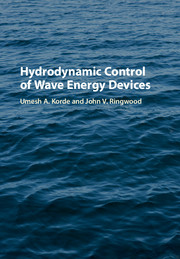Book contents
- Frontmatter
- Contents
- Preface
- Acknowledgments
- Part I Introduction
- Part II The Basics
- Part III The Hydrodynamics
- 5 Nature of the Wave Input
- 6 A Closer Look at Wave Energy Hydrodynamics
- Part IV Velocity Control Using a Hydrodynamic Model
- Part V Control by Optimizing a Performance Index
- Part VI Toward Overall WEC System Hydrodynamic Optimization
- Part VII In Closing
- References
- Index
6 - A Closer Look at Wave Energy Hydrodynamics
from Part III - The Hydrodynamics
Published online by Cambridge University Press: 05 September 2016
- Frontmatter
- Contents
- Preface
- Acknowledgments
- Part I Introduction
- Part II The Basics
- Part III The Hydrodynamics
- 5 Nature of the Wave Input
- 6 A Closer Look at Wave Energy Hydrodynamics
- Part IV Velocity Control Using a Hydrodynamic Model
- Part V Control by Optimizing a Performance Index
- Part VI Toward Overall WEC System Hydrodynamic Optimization
- Part VII In Closing
- References
- Index
Summary
It is the way the oscillating elements and their references respond to each approaching wave (however different from the one before) that determines how much of its energy the device will ultimately absorb. No matter how crucial to energy generation the power take-off (PTO) or the secondary converter may be, how important the generation equipment, how serious the difficulties from a defective mooring, how energy-rich the site of operation, how clever the control system design, it is often the action of the primary energy converter that determines the economic cost competitiveness of a wave energy device. Much of our discussion here therefore concerns the interaction between the primary converter and approaching waves. We cover the whole range, from the oscillation amplitude and the extent to which this oscillation lags behind or leads the surface undulations supplying the energy, to the forces and moments imparted on the device by the wave field. We are particularly interested in the role that the shape and size of the device play in making the best use of the ceaseless rhythmless dialog that describes the work life of a wave energy converter (WEC).
We study what geometries and or motion combinations make devices better at energy absorption, and try to understand precisely where any contributions of control would fit within the “big picture,” as defined by the larger wave-body dynamics. Our goal is to apply control such that the best energy absorption performance enabled by a particular geometry or a particular combination of device oscillations is achieved and sustained through changing wave fields. Our focus in this chapter is therefore on learning the insights provided to us by mathematicians, physicists, and engineers over the last four decades. We will see that, often, most of these insights are most clearly expressed in mathematical terms. While existing quantitative understanding of ship hydrodynamics and floating bodies serves as a starting point, important differences unique to wave energy devices are that the response must often be designed to be different for different elements of a jointed or articulated overall structure, and rather than moving forward steadily and/or minimizing motions through waves, the device should try to maintain its mean position and, when possible, respond in such a way that energy absorption from the surrounding and approaching wave field is maximized.
- Type
- Chapter
- Information
- Hydrodynamic Control of Wave Energy Devices , pp. 113 - 148Publisher: Cambridge University PressPrint publication year: 2016



